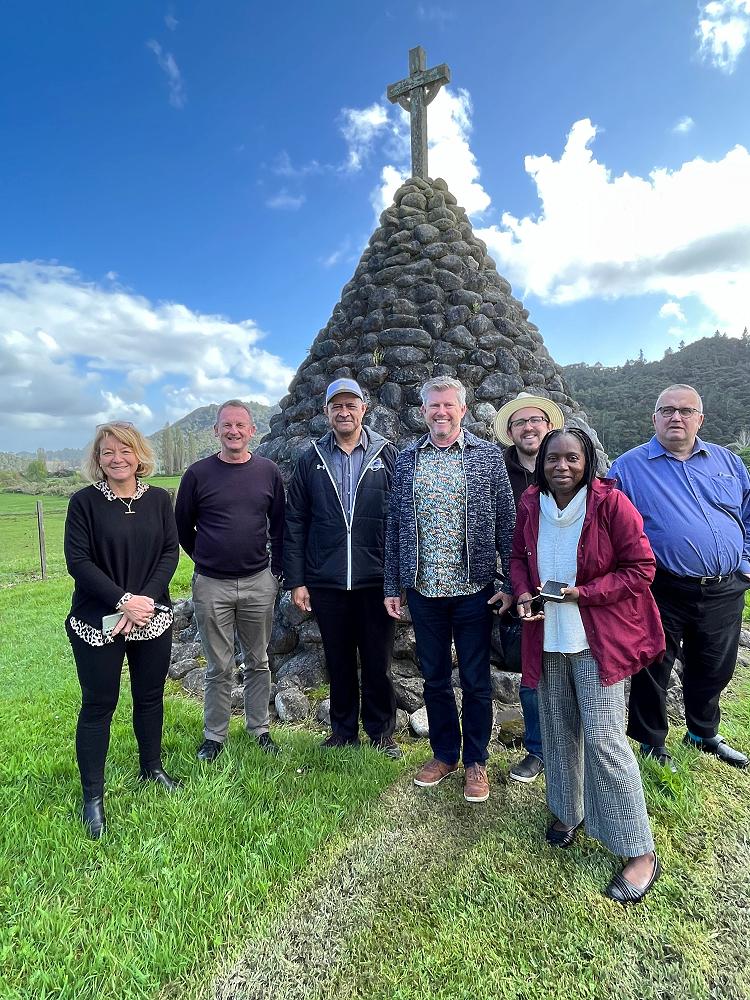
A Northland Pilgrimage of the Anglican-Methodist Dialogue
In October members of the Anglican-Methodist Ecumenical Dialogue visited Northland to make a pilgrimage to a number of places of significance related to our respective missionary beginnings in Aotearoa.
The pilgrimage had been an idea held for a couple of years, but Covid delayed the opportunity. However, its eventual timing appropriately coincided with the upcoming bicentenary of the first Methodist Mission in 1822.
Anglican and Methodist missionary endeavours contributed to the origins of Christianity in Aotearoa, and the collegial relationships between Anglican and Methodist missionary workers in the early days have remained a thread of connectedness linking our two churches. The first Anglican Mission at Rangihoua was the launching point for Wesleyan missionary Samuel Leigh, with the Anglican missionaries there remaining close colleagues to the Wesleyans. Interwoven are the significant contributions of Māori to the Mihinare and Weteriana missions, without whom the missions would not have been possible. As the history of these beginnings unfolds, the missionary societies and the Gospel become interwoven in Te Tiriti, and continue to be expressed in the bicultural partnership of Te Hāhi Weteriana and the tikanga of the Anglican church.
The Dialogue’s pilgrimage started at Kemp House and the Stone Store in Kerikeri (site of the Anglican mission station founded in 1819) and neighbouring Kororipo pa site of Hongi Hika – who supported both the Anglican and Methodist missions. Evening prayer was hosted by St James Anglican Church in Kerikeri.
The following day started in Kaeo at the Methodist Centennial Church and the Memorial Cairn of the first Methodist Mission at Wesleydale (founded 1822). After visiting neighbouring Whangaroa Harbour, the Anglican St Paul’s Church and the Boyd memorial, the team headed inland to Te Waimate Anglican Mission (founded 1830) and St John the Baptist Church. The day concluded at the nearby Mangungu Methodist Mission (founded 1828). Both Te Waimate and Mangungu missions would themselves be locations of significant signing events of Te Tiriti in February 1840. Close-of-day prayers were held on the Mission House veranda while overlooking the Hokianga Harbour.
On the final morning of the pilgrimage, the team gathered at the Methodist-Presbyterian Union Church in Kerikeri to reflect on the insights of the previous two days. Rev Tony Franklin-Ross led an ecumenical Holy Communion to bring the pilgrimage to a close.
Anglican co-chair, Bishop Ross Bay, shared, “It has been really good to understand the ways in which these early Missions worked collaboratively for the sake of the Gospel, rather than seeking to compete over whose church people should join. We pray this spirit of friendship will continue to mark out the ongoing relationship between our two Churches.”
Methodist co-chair, Rev Tony Franklin-Ross, said, “It was great to explore ‘From whence we came’. There are so many common threads, including the close relationships of Anglican Samuel Marsden and Wesleyan Samuel Leigh, and of Maori chief Hongi Hika.”
The Dialogue team reflected on the privilege of visiting the whenua of where we began as Anglicans and Methodists in Aotearoa – we began together, with a sense of belonging and trust. These threads form a whanaungatanga, threads like the forming of a tukutuku panel. But the dynamics changed over following years. What would our contemporary engagement look like in light of this journey, and our Covenant together as Churches, where the calling is not to a denomination but to God’s service?
The pilgrimage was in every sense invaluable to build the relationships of the dialogue team and to help understand where our history and mission are interwoven. The early journeys of our forebears in faith, their mutuality and cooperation, will be a guide to building and extending our Covenant relationships two centuries later.
